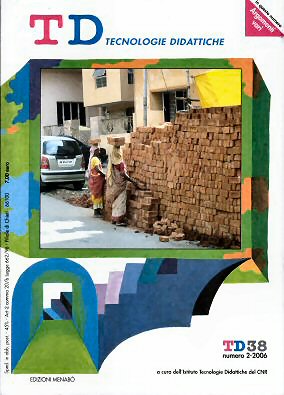Robots as objects-to-develop-with
Main Article Content
Abstract
Article Details
Authors who publish with this journal agree to the following terms:
- Authors retain copyright and grant the journal right of first publication with the work simultaneously licensed under a Creative Commons CC BY 4.0 Attribution 4.0 International License.
- Authors are able to enter into separate, additional contractual arrangements for the non-exclusive distribution of the journal's published version of the work (e.g., post it to an institutional repository or publish it in a book), with an acknowledgement of its initial publication in this journal.
- Authors are permitted and encouraged to post their work online (e.g., in institutional repositories or on their website) prior to and during the submission process, as it can lead to productive exchanges, as well as earlier and greater citation of published work (See The Effect of Open Access)
References
Ackermann E. (1996), Perspective- Taking and object Construction, in Kafai Y. and Resnick M. (Eds.), Constructionism in Practice: Designing, Thinking, and Learning in a Digital World, Lawrence Erlbaum Associates, Mahwah, New Jersey, Part 1, Chap. 2., pp. 25-37.
Baron-Cohen S. (1995), Mindblindness. An essay on autism and theory of mind, MIT Press, Cambridge, Massachusetts.
Braitenberg V. (1984), I veicoli pensanti: saggio di psicologia sintetica, Garzanti, Milano.
Bruner J.S. (1986), Actual minds, possible worlds, Harvard University Press, Cambridge-London [trad. it. La mente a più dimensioni (1988), Laterza, Bari].
Camaioni L. (1995), La teoria della mente, Università Laterza - Psicologia, Bari.
Camaioni L., Bernabei P., Levi G., Di Falco M., Paolesse C. (1997), Lo sviluppo socio-comunicativo nei primi due anni di vita di bambini con autismo: possibilità di una diagnosi precoce, in Psicologia clinica dello sviluppo (1997), Anno I, N. 2, Nucleo monotematico, Il Mulino Ed., Bologna.
Dautenhahn K., Bumby K. (1999), Investigating Children’s Attitudes Towards Robots: A Case Study, Proc. CT99, The Third International Cognitive Technology Conference, August, San Francisco.
Dautenhahn K., Werry, I., Harwin W. (2001), Evaluating the response of children with autism to a robot, Proc. RESNA 2001, Rehabilitation Engineering And Assistive Technology Society Of North America, Friday, June 22 - Tuesday, June 26, 2001, John Ascuaga’s Nugget Hotel, Reno, Nevada, USA.
Dautenhahn K., Werry I., Rae J., Dickerson P., Stribling P., Ogden B. (2002a), Robotic Playmates: Analysing Interactive Competencies of Children with Autism Playing with a Mobile Robot, in Dautenhahn K., Bond A., Canamero L., Edmonds B.(eds.), Socially Intelligent Agents - Creating Relationships with Computers and Robots, Kluwer Academic Publishers.
Dautenhahn K., Billard A. (2002b), Games Children with Autism Can Play With Robot, a Humanoid Robotic Doll, Proc. 1st Cambridge Workshop on Universal Access and Assistive Technology [CWUAAT], in Keates S., Clarkson P.J., Langdon P.M. and Robinson P. (eds.), Universal Access and Assistive Technology, Springer-Verlag, London.
Dautenhahn K., Werry I. (2002c), A Quantitative Technique for Analysing Robot-Human Interactions, Proc. IROS2002, Lausanne, 2002 IEEE/RSJ International Conference on Intelligent Robots and Systems, pp. 1132-1138.
Druin A., Hendler J. (2000), Robot for Kids - Exploring New Technologies for Learning, Morgan Kaufman Publishers, Academic Press.
Goodman N. (1978), Ways of Worldmaking, Hackett, Indianapolis [trad. it. Vedere e costruire il mondo (1988), Laterza, Bari].
Heath C., Luff P. K. (1992), Explicating face to face interaction, in Gilbert N. (ed.), Researching Social Life, Sage, London, pp. 306-327.
Heath C. (2002), Demonstrative suffering: the gestural (re)embodiment of symptoms, Journal of Communication, n. 52, pp. 597-617.
Heath C., Hindmarsh J. (2002), Analyzing Interaction: Video, ethnography and situated conduct, in May T. (ed.), Qualitative Research in Action, Sage, London, pp. 99- 121.
Kafai Y. and Resnick M. (eds.) (1996), Constructionism in Practice: Designing, Thinking, and Learning in a Digital World, Lawrence Erlbaum, Mahwah, NJ.
Malle B., Moses L., Baldwin D. (2001), Intentions and Intentionality. Foundations of social cognition, MIT Press.
McCloud S. (1999), Capire il fumetto. L’arte invisibile, Vittorio Pavesio, Torino.
Papert S. (1994), I bambini e il computer, Rizzoli, Milano.
Poulin - Dubois D., Shultz T. (1989), The infant’s concept of agency: the distinction between social and nonsocial objects, in The Journal of Genetic Psychology, n. 151, pp. 77- 90.
Poulin - Dubois D., Lepage A., Ferland D. (1996), Infants’ Concept of Animacy, in Cognitive Development, n. 11, pp. 19-36.
Tolman E.C. (1939), Prediction of vicarious trial and error by means of the schematic sowbug, Psychological Review, pp. 318-336.
Varisco B.M. (2002), Costruttivismo socio - culturale, Carocci Editore, Roma.
Vygotsky L.S. (1978), Mind in Society: The Development of Higher Psychological Processes, Haward University Press, Cambridge MA.
Woodward A.L. (1998), Infants selectively encode the goal object of an actor’s reach, Cognition, vol. 69, n. 1, pp. 1-34.

